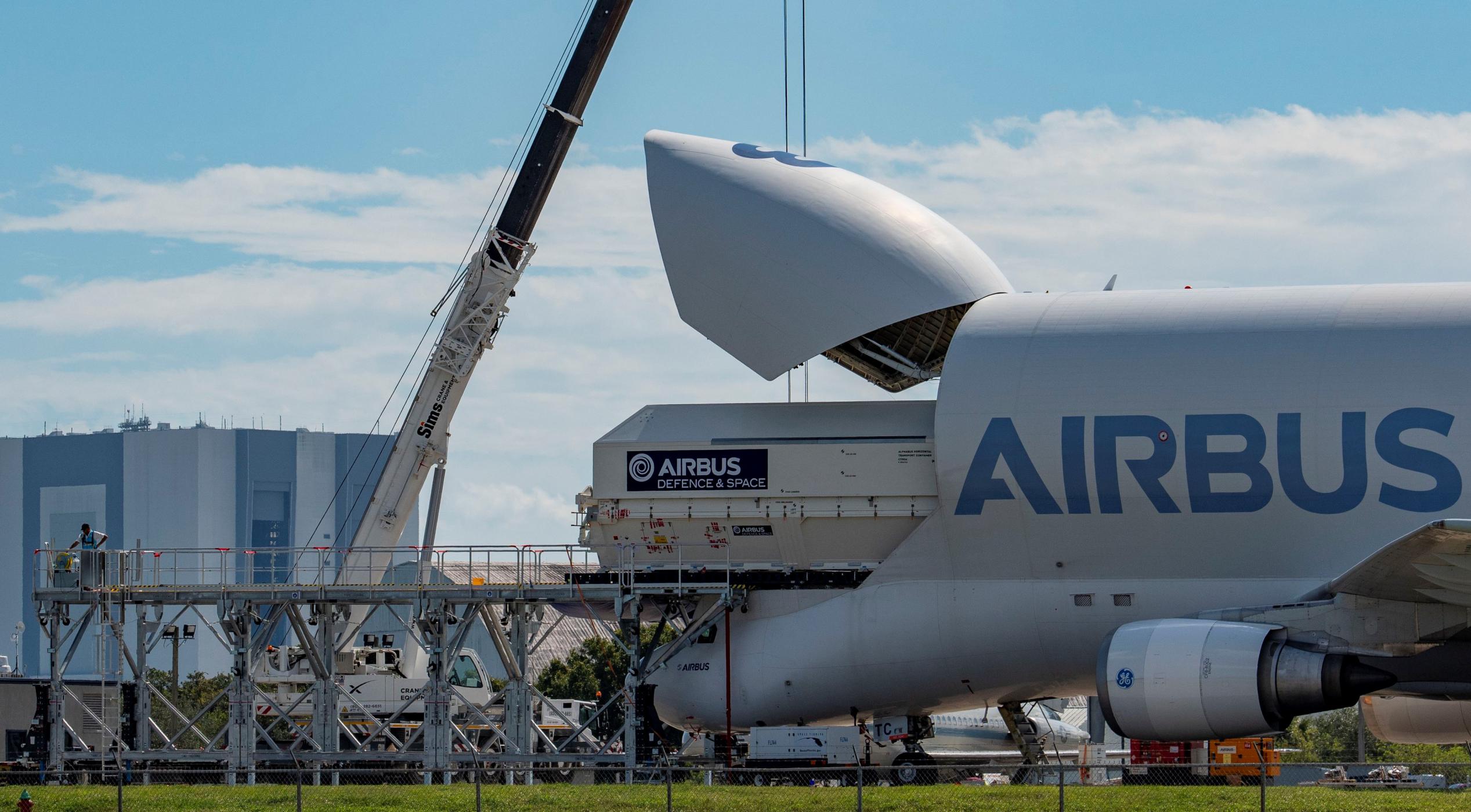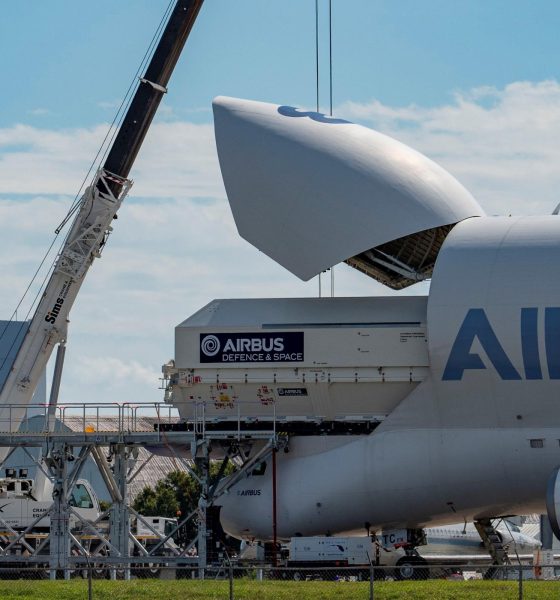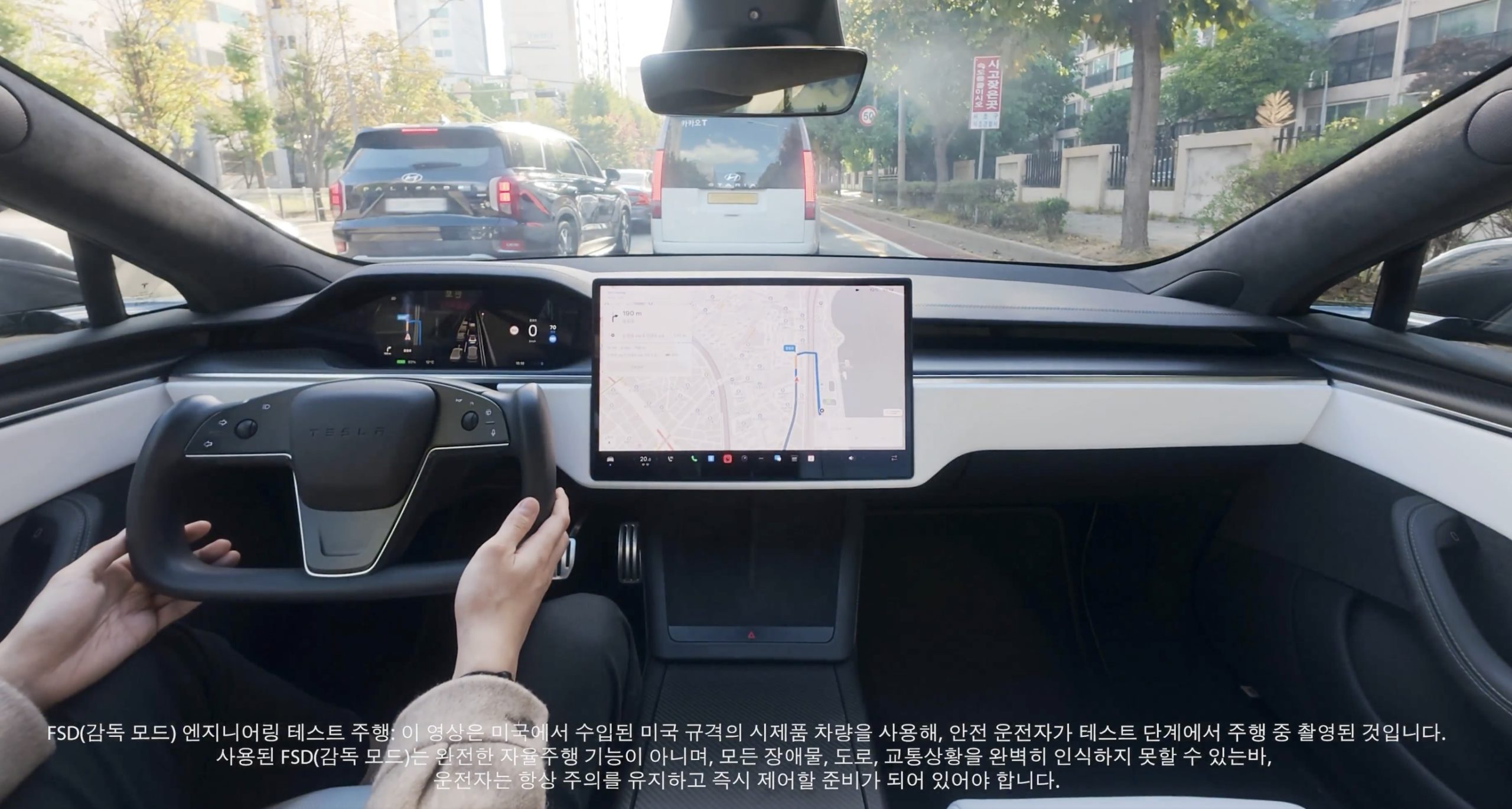

News
European spacecraft converge on the US for rides on SpaceX rockets
Thanks in large part to delays suffered by Arianespace’s next-generation Ariane 6 rocket, a small fleet of European satellites are simultaneously converging on the United States to hitch rides into orbit with SpaceX.
SpaceX launching European payloads is nothing new. The company has occasionally launched spacecraft built in Europe for European space agencies or companies, but the combination is exceedingly rare. For several reasons, however, what was once alien is beginning to become commonplace, and that fact is about to be made even clearer over the remainder of 2022.
SpaceX kicked off a string of six or seven launches of spacecraft built by or for Europe on October 15th. Over the weekend, the company’s workhorse Falcon 9 rocket – 70 meters (230 ft) tall, 3.7 meters (12 ft) wide, and capable of producing up to 770 tons (1.7M lbf) of thrust at liftoff – successfully launched the Hotbird 13F communications satellite into a geostationary transfer orbit (GTO) for the French satcom company Eutelsat.
Hotbird 13F is the first of three Eutelsat satellites the company secretly agreed to launch on SpaceX rockets. Hours after its twin’s launch, Hotbird 13G arrived in Florida in a custom Airbus Beluga XL transport jet (its first visit to the US since 2009) and will soon begin preparing for its own ride on a SpaceX rocket as early as November 2022. Eutelsat 10B, also on track to launch on a Falcon 9 rocket sometime in November, likely left France for Florida on an oceangoing Arianespace ship on October 12th.
Normally, selecting the launch provider for communication satellites that cost eight or nine figures is accompanied by a press release and plenty of celebration. That the European Space Agency, Eutelsat, Airbus, and Thales Alenia said next to nothing until the last moment says a lot about how all parties involved really feel about transferring three of their satellites onto SpaceX rockets. Originally, all three were intended to launch on Arianespace’s rockets: Eutelsat 10B on one of the last Ariane 5s and Hotbird 13F and 13G on one of the first Ariane 6s.
It’s not entirely clear why Ariane 5 wasn’t able to launch Eutelsat 10B, but it’s unsurprising that partners ESA, Thales Alenia, Airbus, and Eutelsat decided to move Hotbird 13F and 13G to Falcon 9. The Ariane 6 rocket meant to launch both satellites simultaneously is years behind schedule, and its launch debut recently slipped even further from late 2022 to sometime in 2023. Originally scheduled to debut in mid-2020, it’s now possible – if not likely – that Ariane 6 won’t be ready to launch until the second half of next year (or even later).
Thanks to those delays, the new rocket will enter the scene with a very busy 2023 and 2024 manifest packed with high-value institutional and commercial payloads from all across Europe. In other words, a pair of semi-commercial communications satellites like Hotbird 13F/13G could have easily been forced to wait for a year or more to launch on Ariane 6. Adding insult to injury, Hotbird 13F and 13G are the first two satellites built under the joint European Space Agency and Airbus Eurostar Neo program, and will now be flying on an American rocket built by a company that is almost singlehandedly responsible for ending a golden era of competitive European launch services.
With confidence in Ariane 6’s debut timing lower than ever, a NASA official recently revealed that ESA is even studying the possibility of launching Euclid – a next-generation two-ton space telescope – on SpaceX’s Falcon 9. Euclid was originally scheduled to launch on one of Arianespace’s Russian-built Soyuz 2.1 rockets (or Ariane 6) in mid-2022. That contract was signed in 2020, six years after Russian President Vladimir Putin reminded the world of his instability, recklessness, and brutality by illegally and unofficially invading Ukraine. In February 2022, after months of obvious buildup, Russia doubled down on its Ukraine offensive with an openly genocidal full-scale invasion. In the aftermath, it kidnapped a batch of European OneWeb satellites, requisitioned a Soyuz rocket the company had already paid for, kneecapped a joint European-Russian Mars mission, and (while mostly mutual) revoked its support of European Soyuz launches.
That has effectively removed Russia as a serious option for European launches or collarboration, leaving several European missions and companies in limbo. Britain’s OneWeb, for example, had an exclusive contract with Russia to launch its entire low Earth orbit (LEO) internet satellite constellation on up to 21 Soyuz rockets. After losing $230 million in the process, the company was forced to abruptly shift gears, and is now on track to launch its first batch of satellites since early 2022 on an Indian SLV-3 rocket. One of at least two SpaceX Falcon 9 missions could follow as early as December 2022. Unless Ariane 6 aces its launch debut in the near future, many more European payloads could find themselves in similar positions in 2023 and 2024.
Meanwhile, several other European-made payloads are preparing for Falcon 9 launches. While these payloads have been assigned to SpaceX rockets from the start, they still demonstrate just how big of a bite the US startup has taken out of the European launch industry. Most recently, the joint NASA-ESA-CSA Surface Water and Ocean Topography (SWOT) spacecraft was flown from France to California on October 17th. Falcon 9 will launch SWOT from the California coast as early as December 2022.
Soon, Japanese startup ispace’s first HAKUTO-R Moon lander – largely assembled, tested, and propellant by France’s ArianeGroup – will be transported from Germany to Florida for a November 2022 SpaceX launch. Germany’s second and third SARah radar satellites could head to the US shortly for a Falcon 9 launch tentatively scheduled as early as the final days of 2022 or early 2023. Finally, SpaceX could complete its first OneWeb launch around the same time.

News
Tesla Full Self-Driving lands in a new country, its 7th

Tesla Full Self-Driving has officially landed in a new country today, its seventh overall after it launched in both Australia and New Zealand earlier this year.
On Sunday, Tesla owners in South Korea reported that the company’s Full Self-Driving (Supervised) had started arriving in their vehicles. Owners reported that it was v14.1.4, which is not the latest version available in other countries, but is one of the most recent releases Tesla has deployed to drivers:
From 6 to 7
Tesla Full Self-Driving has launched in South Korea; the 7th country to have FSD https://t.co/X6gm1SyoxV
— TESLARATI (@Teslarati) November 23, 2025
This marks the seventh country in which Tesla has enabled its Full Self-Driving suite, following the United States and Puerto Rico, Canada, China, Mexico, Australia, and New Zealand.
Tesla launched Full Self-Driving most recently in Australia and New Zealand about three months ago. The expansion is a major breakthrough for the company as it aims to launch Full Self-Driving on a global scale.
However, the company’s biggest challenge thus far has been getting European regulatory agencies to handle the red tape that has inhibited Tesla from launching its semi-autonomous driving suite on the continent. Recently, it admitted that it sees a pathway through Dutch regulatory bodies, which seem to be the most willing to work with Tesla to get FSD in Europe.
Tesla Full Self-Driving appears to be heading to Europe soon
The company said that it has driven over 1 million kilometers safely on European roads across 17 different countries in internal testing. But its path to success will be by “partnering with the Dutch approval authority RDW to gain exemption for the feature. This involves proving compliance with existing regulations (UN-R-171 DCAS) + filing an exemption (EU Article 39) for yet-to-be-regulated behaviors like Level 2 systems off-highway, system-initiated lane changes with hands-off the wheel, etc.”
Perhaps the expansion into Europe will be the biggest challenge for Tesla, but it could also yield major results and advantages for the company moving forward. Tesla said it hopes to have FSD available in Europe sometime early next year.
For now, the expansion in South Korea is the latest win for Tesla and its self-driving efforts. In the U.S., it now turns its focus toward fully autonomous operation, as it works with state agencies to launch Robotaxi outside of Texas, California, and most recently, Arizona.
Elon Musk
Tesla CEO Elon Musk teases insane capabilities of next major FSD update

Tesla CEO Elon Musk teased the insane capabilities of the next major Full Self-Driving update just hours after the company rolled out version 14.2 to owners.
Tesla Full Self-Driving v14.2 had some major improvements from the previous iteration of v14.1.x. We were on v14.1.7, the most advanced configuration of the v14.1 family, before Tesla transitioned us and others to v14.2.
However, Musk has said that the improvements coming in the next major update, which will be v14.3, will be where “the last big piece of the puzzle finally lands.”
14.3 is where the last big piece of the puzzle finally lands
— Elon Musk (@elonmusk) November 21, 2025
There were some major improvements with v14.2, most notably, Tesla seemed to narrow in on the triggers that caused issues with hesitation and brake stabbing in v14.1.x.
One of the most discussed issues with the past rollout was that of brake stabbing, where the vehicle would contemplate proceeding with a route as traffic was coming from other directions.
We experienced it most frequently at intersections, especially four-way stop signs.
Elon Musk hints at when Tesla can fix this FSD complaint with v14
In our review of it yesterday, it was evident that this issue had been resolved, at least to the extent that we had no issues with it in a 62-minute drive, which you can watch here.
Some owners also reported a more relaxed driver monitoring system, which is something Tesla said it was working on as it hopes to allow drivers to text during operation in the coming months. We did not test this, as laws in Pennsylvania prohibit the use of phones at any time due to the new Paul Miller’s Law, which took effect earlier this year.
However, the improvements indicate that Tesla is certainly headed toward a much more sentient FSD experience, so much so that Musk’s language seems to be more indicative of a more relaxed experience in terms of overall supervision from the driver, especially with v14.3.
Musk did not release or discuss a definitive timeline for the release of v14.3, especially as v14.2 just rolled out to Early Access Program (EAP) members yesterday. However, v14.1 rolled out to Tesla owners just a few weeks ago in late 2025. There is the potential that v14.3 could be part of the coming Holiday Update, or potentially in a release of its own before the New Year.
News
Tesla Full Self-Driving v14.2 – Full Review, the Good and the Bad

Tesla rolled out Full Self-Driving version 14.2 yesterday to members of the Early Access Program (EAP). Expectations were high, and Tesla surely delivered.
With the rollout of Tesla FSD v14.2, there were major benchmarks for improvement from the v14.1 suite, which spanned across seven improvements. Our final experience with v14.1 was with v14.1.7, and to be honest, things were good, but it felt like there were a handful of regressions from previous iterations.
While there were improvements in brake stabbing and hesitation, we did experience a few small interventions related to navigation and just overall performance. It was nothing major; there were no critical takeovers that required any major publicity, as they were more or less subjective things that I was not particularly comfortable with. Other drivers might have been more relaxed.
With v14.2 hitting our cars yesterday, there were a handful of things we truly noticed in terms of improvement, most notably the lack of brake stabbing and hesitation, a major complaint with v14.1.x.
However, in a 62-minute drive that was fully recorded, there were a lot of positives, and only one true complaint, which was something we haven’t had issues with in the past.
The Good
Lack of Brake Stabbing and Hesitation
Perhaps the most notable and publicized issue with v14.1.x was the presence of brake stabbing and hesitation. Arriving at intersections was particularly nerve-racking on the previous version simply because of this. At four-way stops, the car would not be assertive enough to take its turn, especially when other vehicles at the same intersection would inch forward or start to move.
This was a major problem.
However, there were no instances of this yesterday on our lengthy drive. It was much more assertive when arriving at these types of scenarios, but was also more patient when FSD knew it was not the car’s turn to proceed.
Can report on v14.2 today there were ZERO instances of break stabbing or hesitation at intersections today
It was a significant improvement from v14.1.x
— TESLARATI (@Teslarati) November 21, 2025
This improvement was the most noticeable throughout the drive, along with fixes in overall smoothness.
Speed Profiles Seem to Be More Reasonable
There were a handful of FSD v14 users who felt as if the loss of a Max Speed setting was a negative. However, these complaints will, in our opinion, begin to subside, especially as things have seemed to be refined quite nicely with v14.2.
Freeway driving is where this is especially noticeable. If it’s traveling too slow, just switch to a faster profile. If it’s too fast, switch to a slower profile. However, the speeds seem to be much more defined with each Speed Profile, which is something that I really find to be a huge advantage. Previously, you could tell the difference in speeds, but not in driving styles. At times, Standard felt a lot like Hurry. Now, you can clearly tell the difference between the two.
It seems as if Tesla made a goal that drivers should be able to tell which Speed Profile is active if it was not shown on the screen. With v14.1.x, this was not necessarily something that could be done. With v14.2, if someone tested me on which Speed Profile was being used, I’m fairly certain I could pick each one.
Better Overall Operation
I felt, at times, especially with v14.1.7, there were some jerky movements. Nothing that was super alarming, but there were times when things just felt a little more finicky than others.
v14.2 feels much smoother overall, with really great decision-making, lane changes that feel second nature, and a great speed of travel. It was a very comfortable ride.
The Bad
Parking
It feels as if there was a slight regression in parking quality, as both times v14.2 pulled into parking spots, I would have felt compelled to adjust manually if I were staying at my destinations. For the sake of testing, at my first destination, I arrived, allowed the car to park, and then left. At the tail-end of testing, I walked inside the store that FSD v14.2 drove me to, so I had to adjust the parking manually.
This was pretty disappointing. Apart from parking at Superchargers, which is always flawless, parking performance is something that needs some attention. The release notes for v14.2. state that parking spot selection and parking quality will improve with future versions.
Any issues with parking on your end? 14.1.7 didn’t have this trouble with parking pic.twitter.com/JPLRO2obUj
— TESLARATI (@Teslarati) November 21, 2025
However, this was truly my only complaint about v14.2.
You can check out our full 62-minute ride-along below:








